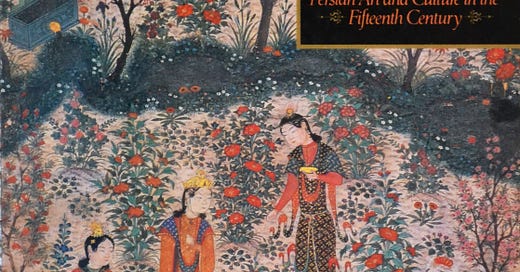I recently read My Name is Red by the Turkish author Orhan Pamuk. I have a lot to say about My Name Is Red, but one thing that I found fascinating was that the miniaturist characters had a sense that the artform in which they were engaged had reached its apogee about a hundred years earlier in Herat, Afghanistan. Herat was where Shahruhk, a son of Timur, set up a book workshop, where the many artists who created illustrated books worked. In my massive post about Timur, I looked down my nose at the “Timurid renaissance” for producing book arts. It seemed like a thin reed on which to hang a so-called “renaissance”. But what My Name Is Red has convinced me was that book arts and the art of miniature paintings that was a major part of book arts were, in fact, major artforms. In other words, the Timurid Rennaissance was a real thing.
Because I read My Name Is Red, it has made me fascinated in the art of the Persian Miniature. (The name “persian miniature” is a little misleading, since there were important book workshops in the Ottoman Empire and in Moghul India.)
I recently got a copy of a book called Timur and the Princely Vision: Persian Art and Culture in the Fifteenth Century. It is a big catalog for a 1989 exhibit at the Los Angeles County Museum of Art. Specifically, it was shown in the Arthur M. Sackler Gallery.
The Sacklers were the family behind Purdue, the drug manufacturer that spent years marketing addictive pain killers to Americans, most dangerously a drug called OxyContin. OxyContin was a very addictive opioid pain killer that Purdue encouraged doctors to prescribe for pain. Perhaps sensing how fucking evil they were, the Sackler family spent a lot of money “art washing” their reputation. Various Sacklers funded galleries at some of America’s greatest museums. (I recommend Patrick Radden Keefe’s great history of Purdue and the Sacklers, Empire of Pain.)
When I opened Timur and the Pricely Vision: Persian Art and Culture in the Fifteenth Century and saw that the exhibit had been in the Arthur M. Sackler Gallery, I had a grim thought. Who murdered more? Timur or the Sacklers. Timur is estimated to have killed 17 million people. The Sacklers were far less lethal—according to a BBC article, they only killed 218,000 people to overdoses. So Timur wins this historical death race!
[Please consider supporting this publication by becoming a patron, and you can also support it by patronizing our online store. And one more way to support this work is to buy books through The Great God Pan is Dead’s bookstore. ]





I share your current interest in the miniatures from the Asian kingdoms. I had the privilege of working for several decades with a major museum’s collection of those paintings and never ceased to be hypnotically transported into their detailed worlds; As an artist, I did a series of paintings inspired by the luscious margins surrounding the scenes. Nice topic for further study, Robert.